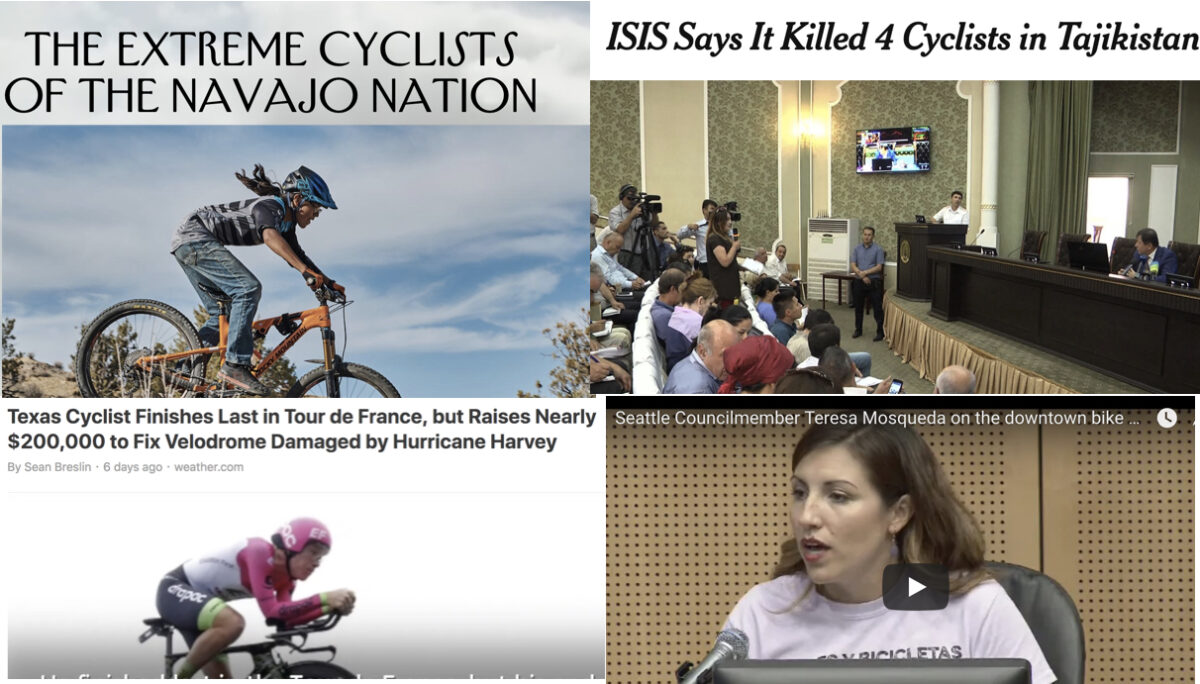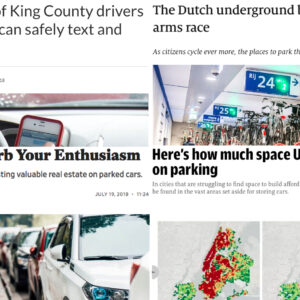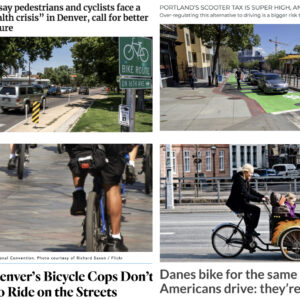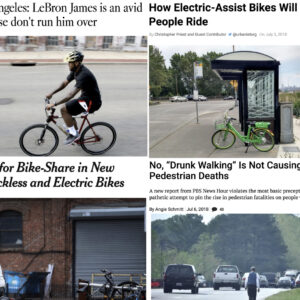Welcome to the week! Before we share some great stories, here’s a quick word from an excellent sponsor: NW Connector is a bike-friendly collection of transit services that connect Portland, the Oregon Coast, and beyond. Plan your next adventure at NWConnector.org.
And here are the best stories we came across in the past week…
Steel horses: The New Yorker profiled a group of young tribal members who have left their horses in the stable and taken up mountain bike riding on their Navajo Nation reservation.
Way to go LeBron! I have mixed feelings about NBA superstar LeBron “King” James as a basketball player, but his recent moves off-the-court have made me an unwavering fan. The excellent Jason Gay of the Wall St. Journal just published an interview with James that covers many topics, including the new school he opened up where each kid gets a free bike.
Dangerous driving is an American epidemic: Residents in the Florida city of Tampa are so desperate for people to slow down they’re standing in front of their houses holding signs that say things like, “You’re driving a deadly weapon” and “Your car can kill.”
Emotional abuse of planners: USC Urban Planning professor Lisa Schweitzer has received death threats. She thinks the public’s wrath has a lasting impact on planners and wants more studies and conversation about it.
How to be first while coming in last: After a crash in an early stage left him hurting, U.S. professional cyclist Lawson Craddock struggled to finish the epic Tour de France. But in the process he raised $200,000 to repair his hometown velodrome and became a hero to many in the process.
Scooters? Ban ’em: A city council member in Los Angeles has proposed an ordinance that would ban the use of electric scooters, “Until firm regulations are in place to protect riders and pedestrians.”
Rules worth considering: I’m not usually one for lists of “cycling rules,” but former pro Phil Gaimon is a pretty good guy and I think his are worth your time.
Advertisement
Tesla’s new “iPhone” car: While some people act concerned about the safety of scooters, one of the darlings of the auto world is putting out cars that the Wall Street Journal says is rife with distractions and is akin to an iPhone on wheels.
The lower MPG safety argument: The Trump administration wants to roll back Obama’s higher MPG mandate and their argument is that people will drive more if they got better gas mileage, thus leading to more crashes. They also say the use of smaller, more fuel-efficient cars aren’t as safe as gas-guzzling behemoths like SUVs and trucks.
Car abuse is the problem: Alissa Walker argues that if “climate mayors” really want credibility around transport-related GHG emissions, they should focus less on fighting Trump’s MPG rollback and more on reducing the demand to drive in the first place.
Biking’s impact on kids: Interesting study from Mexico (translate page for English) shows how young people perceive their neighborhood differently when they ride to school, versus being driven to school.
Terror tour: ISIS has taken credit for a gruesome attack on a group of bicycle riders who were on a bicycle tour in Tajikistan.
This is how you do it: A pre-vote speech by Seattle City Councilwoman Teresa Mosqueda is being hailed by activists as an excellent example of active transportation leadership. Is there anyone on Portland City Council that could manage this?
— Jonathan Maus: (503) 706-8804, @jonathan_maus on Twitter and jonathan@bikeportland.org
Never miss a story. Sign-up for the daily BP Headlines email.
BikePortland needs your support.








Thanks for reading.
BikePortland has served this community with independent community journalism since 2005. We rely on subscriptions from readers like you to survive. Your financial support is vital in keeping this valuable resource alive and well.
Please subscribe today to strengthen and expand our work.
Mixed feelings about LeBron as a basketball player? 🙂
Something on this earth is really screwed up that anyone should be worth that much income a year! Not talking about LeBron personally.
Can’t decide if he is the best ever or tied with MJ as the best perhaps? On bikes I do like how part of his story is the freedom and fun bike riding gave him as a child. I think we all have similar stories.
Very much better than MJ!
Also does not ride electric.
I could be a fan of scooters, but I’m not. There’s obviously a hot market for the service … but it’s starting to feel like the client base doesn’t understand that the functional use includes public safety and comfort. Therefore, the owners of the service need to build this element of public trust into the business plan. How? I don’t know.
3 complaints and you don’t get to play anymore? Oh, boy. More chances to introduce arbitration into a dispute between two people.
Separate the infrastructure? (Cars on highways will be banned before this happens.)
Automatic warning devices on the machines? Maybe, but jeez, how much more do we want to add to the noise pollution.
(Unless it was the sound that spokes make on a playing card – I’d be OK with that!)
Right now, scooters are just annoying toys, but they could be another arrow in the quiver of true public transportation; unfortunately, at this rate they’re going to get banned as a public nuisance.
Saw one abandoned on the Springwater this morning, just in front of the road block where they’re doing the road work.
Lying on the path, I thought abandoned. By the time of my evening commute, it was upright and waiting for the next user, although I suspect it had no charge.
Jonathan – thanks for including the article by USC Urban Planning professor Lisa Schweitzer. It is spot on…and I would have not known about it otherwise.
[I have seen a lot of what she describes…especially the public emotions about inserting bike / active transportation infrastructure into the public realm, its getting easier but its still a “street-fight”. And additionally – happy “planner’s birthday” to me – this is my 30th year in the planning field, so to my fans, please send me my pearls.]
Schweitzer didn’t mention in her piece that planners brought us much of our modern urban form, often over the loud objections of NIMBYs who didn’t want their communities razed to make way for a highway.
Some planners seem completely oblivious to reality, drawing colored lines on maps of areas they have no real experience with, ignoring those who do. And being on the speartip of unwanted change will, of course, attract ire.
That said, we all have an obligation to be civil, and while having your community threatened may make people feel powerless and angry, death threats are simply unacceptable.
As a trained “planner”, I take pride in the impact we’ve made in our world, but oftentimes we are given far more credit than we deserve. Hello, Kitty, I’m flattered that you and others believe we planners are responsible for designing Portland. How I wish it was true.
Most of your urban form was created long before urban planners became involved. The field itself wasn’t even called “planning” until the 1930s when separated land use became “normal”, though the profession has existed under various names since ancient times, usually as surveyors or as architects. The main grid of Portland, like most of the West, was laid out by army surveyors in the 19th century, aside from a few Indian roads and paths such as Sandy. The subsequent infill was done, and continues to be done, by various developers. The “lines on the map” for highways were more often than not created by highway engineers or by outside consultants such as Olmstead (an architect) and Robert Moses.
Someone planned the street grid, whether it be a “planner” or a “surveyor”. Nonetheless, I was thinking more of our great highway system that keeps vehicles flowing and the engines of commerce purring.
Moses (who also built many parks) was most definitely a planner, even if he had a different job title.
That speech by Teresa Mosqueda is excellent. I highly recommend watching it.
In fairness, I didn’t read the plan she was endorsing, but the speech left me wondering what, exactly, she was advocating for. It sounded much like a word salad of desirable outcomes without ever discussing which ox was getting gored. Coming out in favor of apple pie is all well and good, but at some point you have to decide if it’s going to be an organic vegan apple pie or something from Marie Callenders.
It looked a lot like sausage to me. I agree, the devil is in the details. Given the terrain and past development, there’s only so much you can afford to do to make South Park be like Queen Ann Hill. And then again, do you really want to do so? Is the point to gentrify South Park to the point it’s like Queen Ann? Do you really want several varieties of caviar, rather than a heterogeneous mix of scones and tamales?
I can’t believe Gaimon didn’t even mention cookie consumption.
After reading these stories, an objective third party observer would come to the conclusion that automobiles were an alien technology sent to earth to destroy human social interactions, societies, our habitat and even humans themselves. We thought it would be saucers with death rays but happy motoring seems to do the job all by itself.
Had I ever gone the PhD route, my thesis was going to be on something similar. How urban planning has impacted human interactions through planned design and defined use.
Funny how Gaimon can simultaneously say “wear whatever you want” as one rule, and then insist that people on a given group ride should be able to insist on helmets and not see that he’s falling into the “one right way to ride” group that has so harmed cycling participation numbers. Even his insistence that he can determine who is riding safely and who isn’t is problematic.
Maybe he should simplify:
1. When people ride bikes it’s a good thing. Even those who appear to you to be dangerous are probably doing less harm on a bike than they would if they reverted to driving, so count your blessings.
2. Don’t be a dick, especially where children are involved. Kids have an absolute (moral) right of way.
3. Just ride. Don’t complain that someone is doing it wrong, don’t insist your way is the only right way or even the best way for anyone but you. Just ride your bike/trike/quadracycle/unicycle/e-whatever whenever and however it is you do it and let others do the same.
4. Try to pay enough attention to your surroundings that you don’t inadvertently harm someone or come to harm yourself.
5. The only advice anyone appreciates and follows is solicited advice. The unsolicited kind is a waste of breath.
I think he was asking that we respect the wishes of the ride leader. And what’s wrong with that? If a bike shop sponsors a Saturday 30 mile hilly ride with a requirement that all participants wear helmets, than either choose to comply or choose to ride somewhere else that day.
I sure wish there was an edit button on this blog.
You ask what’s wrong with allowing group rides, which are historically open all-comers, to restrict the ride to those who will follow a dress code. You call it respecting the wishes of the ride leader, but it’s also the ride leader disrespecting the riders. No wonder we’re losing riders left and right.
On the specific helmet thing, I know riders who feel that their girth makes them more prone to overheating with a helmet and thus refuse to wear them. I know riders who won’t wear them because they have seen data that says they are more likely to get hit by motorists if they wear a helmet. Of course I know riders who simply don’t like wearing helmets for retrogrouch and other stylistic reasons. Shall we just tell these people to go away? Our tents are already shamefully small, do we need to turn them into bivouac sacks?
Because THEN I would fix a spelling error in my post.
Corect speling es overated.